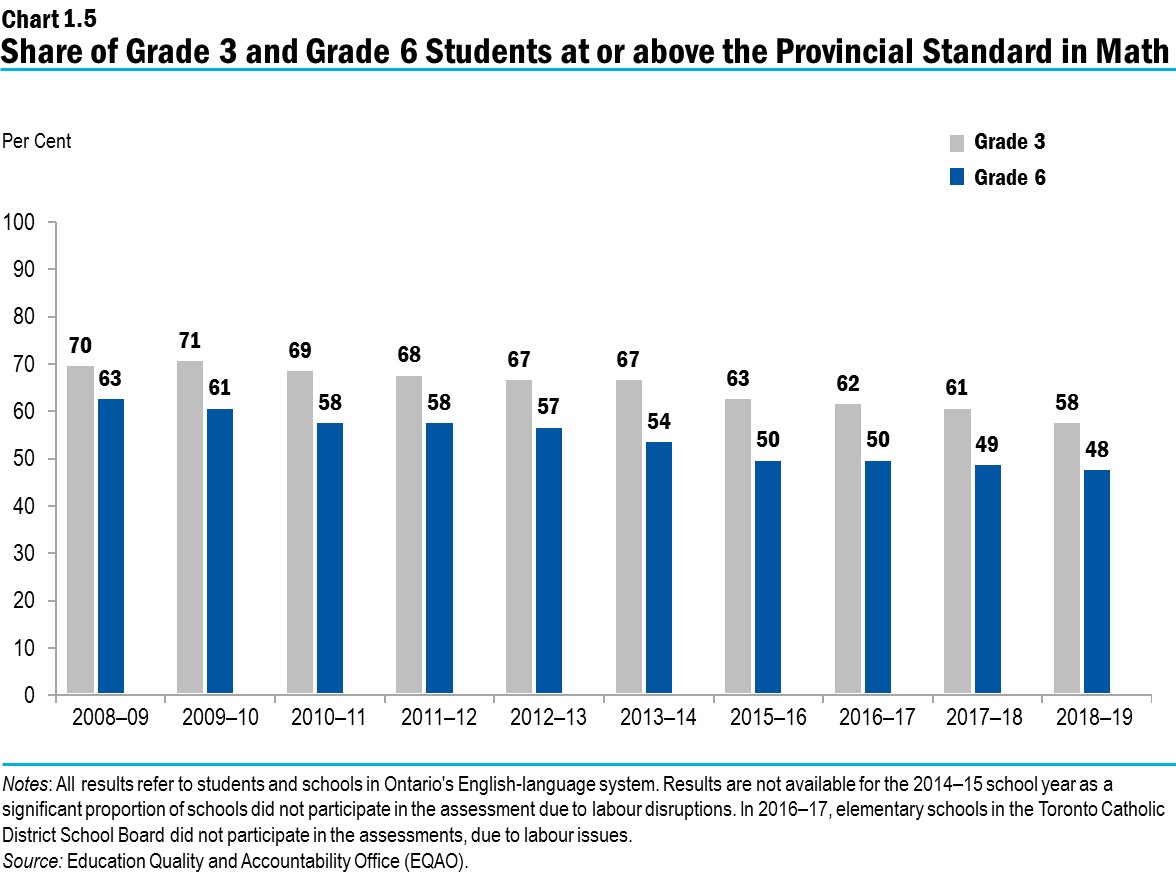On this page Skip this page navigation
- Introduction
- Transforming K-12 Education
- Improving Indigenous Education
- Promoting Excellence in Postsecondary Education
- Making Postsecondary Education More Accessible
- Funding for the Université de l’Ontario français
- Transforming the Skilled Trades and the Apprenticeship System
- Transforming Ontario’s Employment Services
- Improving Skills Training and Attracting Skilled Workers
Introduction
The government has a plan to make sure today’s students, and tomorrow’s entrepreneurs, innovators, and workers, have the skills they need to succeed in a highly competitive global economy. From the first day students step inside the classroom to the day they graduate and start their careers, as well as throughout their working lives, the government is focused on ensuring every person in Ontario has the opportunity to reach their full potential.
Advances in technology, globalization and an aging population are just a few of the challenges facing Ontario’s workforce, for people of all ages and skill levels. An education and training system that has not kept pace with the economy’s demands does not allow for the flexibility needed to respond to this new reality. As a result, Ontario is facing a mismatch: employers cannot find the workers they need, and workers cannot find the jobs that match their skill set.
That is why the government is investing in education and skills training programs from preschool through to adult employment services. The government has a plan to prepare people for jobs by transforming and modernizing Ontario’s educational and employment training systems. By putting more emphasis on science, technology, engineering and math (STEM), lowering tuition for postsecondary education and linking funding for colleges and universities to performance, students and workers will be prepared to succeed in the global economy.
Transforming K-12 Education
Focusing on Science, Technology, Engineering and Math
Ontario is helping students across the province to prepare for successful careers. The government is placing a renewed focus on science, technology, engineering and math (STEM) as well as the skilled trades. The K-12 Ontario STEM Education Strategy will enable the province to become a global leader in STEM learning. The strategy includes updating the mandatory Grade 10 Career Studies course to focus on the changing nature of work, the role of transferable skills, and the importance of STEM in key high growth industries. The strategy will also include revising the Business Studies and Computer Studies curricula to focus on developing job skills, such as computational thinking and coding.
In July 2019, the Ontario and Alberta governments signed a Memorandum of Understanding to enhance learning opportunities for students in these fields of study. This agreement between Ontario and Alberta will support and enhance opportunities for elementary and secondary students in STEM fields and ensure that the skilled trades are recognized as a career of choice by young people, parents and educators.
Introducing a Math Strategy

The government remains committed to ensuring that students have the skills they require to succeed. As part of that commitment, the government is revising the Ontario curriculum to improve math skills for all students based on research and feedback from public consultations.
The Education Quality and Accountability Office (EQAO) assessments have shown a decline in provincial performance in both Grade 3 and 6 mathematics in the English-language school systems over the past decade. From 2008–09 to 2018–19, the proportion of Grade 3 students who met the provincial standard in math dropped to 58 per cent from 70 per cent. The proportion of Grade 6 students who met the provincial standard only reached 48 per cent in the 2018–19 school year, a decline from 63 per cent in 2008–09.

In response to the declining performance, the Province is investing $200 million in a new four-year math strategy to focus on fundamental math concepts and skills as well as their application. This strategy will ensure that students have the skills to succeed in the classroom and beyond, and that teachers have the knowledge and resources to focus on teaching math fundamentals.
Beginning with an investment of $55 million in the 2019–20 school year, the funding will support critical programming and resources for students and educators. This includes investing in professional development to ensure new teachers entering the profession have the skills to teach math, and supporting additional qualification math courses for teachers, as well as summer learning programs and expanding online tutoring programs for students.
Modernizing Classrooms
Digital skills are essential for students if they want to compete in the rapidly evolving global economy. To better prepare students for the future, the government has a plan to modernize classrooms across the province in several innovative ways.
Focusing Classroom Learning
The classroom is for learning and cellphones can be a distraction. The Province is moving forward with limiting the use of cellphones and other personal mobile devices in classrooms. As of November 4, 2019, using cellphones during instructional time is only permitted for educational purposes (as directed by the educator), health and medical purposes, or to support special education needs.
Adopting a Digital Curriculum
Technology is evolving. This is why the government is developing a new user- and mobile-friendly digital platform to modernize Ontario’s curriculum. The platform will clearly outline and communicate learning objectives by providing students, parents and educators with interactive online access to the curriculum and learning resources. The first phase of this digital learning platform will be launched in fall 2019.
Supporting Students’ Mental Health

Evidence shows 70 per cent of mental health problems begin in childhood or adolescence.1 It is important to equip young people with the knowledge and skills they need to support their mental health throughout their lives.
To provide better support for students, the Province has implemented a new Health and Physical Education curriculum for Grades 1 to 8, with a more comprehensive approach to mental health. Changes to the curriculum include new learning expectations that focus on developing social-emotional learning skills and building a better understanding of mental health.
The Province is providing an investment of nearly $40 million, more than double the funding from 2017–18, to advance student mental health in partnership with education groups. This includes $25 million in permanent funding for approximately 180 mental health workers in secondary schools (such as social workers, psychologists and psychotherapists) to better serve students with mild to moderate mental health issues. By intervening early and providing more and consistent evidence-based mental health supports to students in schools, the Province is helping students reach their full potential.
Accepting Service Animals in Schools
The Province is committed to supporting school boards by providing appropriate accommodations to all students with demonstrable learning needs, including special education programs and services in Ontario’s schools.
The Province is also supporting students and their families making requests to bring their service animals into schools and classrooms to help them experience a more consistent, fair and transparent process. Starting in January 2020, all school boards in Ontario will be required to implement — and make publicly available on their websites — their newly developed or updated policies and procedures on student use of service animals.
Building and Renewing Schools

Better buildings support better learning for Ontario students. This is why the Province is investing almost $13 billion in capital grants2 over a 10‐year period to help build new schools in high‐growth areas and improve the condition of existing schools, including an investment of $1.4 billion in school renewal in the 2019–20 school year. Furthermore, the government has committed up to $1.0 billion over the next five years to create up to 30,000 child care spaces in schools, including approximately 10,000 spaces in new schools.
All across Ontario, the government is building new schools and child care spaces, as well as investing in major additions to existing schools, to support better learning environments for the next generation. This includes:
- North: The recently opened Sioux North High School in Sioux Lookout, which includes space for 513 students.
- East: A major addition at St. Joseph Catholic Secondary School in Ottawa, scheduled to open in September 2020, which will offer space for 650 additional students.
- Central: A new elementary school in North Ajax, which, when complete, will include space for 558 students and an EarlyON Child and Family Centre room to provide more families with high‑quality child care.
- Southwest: The new Georgian Bay Community School in Meaford, which, when complete, will include space for 1,033 students and an EarlyON Child and Family Centre room.
The government is working with its school board partners and taking decisive action to ensure students have safe and modern learning environments that enable their success in the classroom, in life and in the labour market. Since June 2018, the Province has approved the construction of about 80 school and child care capital projects, and this summer launched the 2019–20 Capital Priorities Program, which provides school boards with the opportunity to access funding for large‑scale projects in every region of the province.
Improving Indigenous Education
Reducing barriers to quality education for Indigenous learners supports the government’s vision for an education system that works for all students and families. To promote Indigenous student wellness and academic achievement, the Province is investing $3.7 million in 2019–20 to support a revised First Nations, Métis and Inuit studies curriculum for Grades 9–12 and the Indigenous Graduation Coach Program in targeted district school boards.
Seamless Education for First Nation Students

The Province is improving access to education for First Nation students in Ontario. Beginning fall 2019, a new Reciprocal Education Approach (REA) will create a consistent and transparent process for eligible First Nation students and their families when they choose to study at a publicly funded school or a First Nation-operated school. The new approach will eliminate the requirement for formal agreements on base fees. As part of the REA, Ontario is also ensuring that students attending a school of a provincially funded board can continue to be represented by a First Nation trustee.
Supporting Education for Urban Indigenous Communities
Ontario remains committed to supporting education for urban Indigenous communities. The Province is funding the River Program, an Indigenous-based holistic approach to education with wrap-around supports and community connections, including regular visits from traditional peoples, knowledge holders, and Elders. The program runs parallel with the provincial school system and integrates cultural teachings, workshops, family activities, educational supports, mental health supports, and career and job training into the programming.
Improving Educational Outcomes
Not all Indigenous students are having their education needs met through mainstream school systems. Recognizing that every student is unique, the Province is continuing to support the Ontario Federation of Indigenous Friendship Centres’ Alternative Secondary School Program. The program improves social and educational outcomes by supporting students in the completion of their Ontario Secondary School Diploma. The program is geared to meet students’ individual needs and re-engages disenfranchised urban Indigenous students who have not connected to mainstream classroom settings.
Promoting Excellence in Postsecondary Education

Students graduating from Ontario’s universities and colleges should have the skills and competencies to compete and succeed in today’s highly competitive labour market. Strategic Mandate Agreements (SMAs), negotiated between the Ministry of Colleges and Universities and Ontario’s publicly assisted colleges and universities, help promote institutional excellence and student success.
Traditionally, only a small portion of public funding, 1.2 per cent for colleges and 1.4 per cent for universities, has been linked to performance. As the current SMAs expire on March 31, 2020 and new ones are negotiated, the government is moving to increase accountability through an outcomes-based funding model, linking 60 per cent of operating funding to performance by the 2024–25 academic year.
Funding will be linked to performance on the following metrics that align with the Province’s priorities in skills and job outcomes, and economic and community impact:
- Proportion of graduates with at least one experiential learning course;
- Graduate employment earnings;
- Student skills and competencies-related metric;
- Proportion of graduates employed full time in a related or partially related field to their program of study;
- Proportion of students in an identified area of institutional strength and focus;
- Graduation rate;
- Total and share of federal Tri-Council3 funding (universities only); institution-specific apprenticeship-related metrics (colleges only);
- Research revenue (universities) and revenue (colleges) attracted from private-sector sources;
- Student population as a proportion of local population; and
- Institution-specific economic impact metric.
Through the new SMAs, Ontario will become an international leader in outcomes-based funding. This will ensure that Ontario’s postsecondary education system is focused on differentiated improvement and on offering programs aligned with labour market needs.
Making Postsecondary Education More Accessible
Ensuring postsecondary education affordability is part of the government’s plan to help more people access postsecondary education and develop the skills they need to find work. The government has implemented a historic tuition reduction of 10 per cent across all funding-eligible programs in the 2019–20 academic year and will freeze tuition fees in the 2020–21 academic year. For examples of the impacts on savings for families, see Chapter 1, Section A: A Plan to Build Ontario Together by Making Life More Affordable.
Funding for the Université de l’Ontario français
The government recognizes the contribution of the Francophone community to the province’s social, cultural and economic development and wants to ensure that French-speaking students have access to postsecondary education that is aligned with labour market needs.
Ontario is working with the Government of Canada on the establishment of the Université de l’Ontario français to address the needs of about 622,000 Francophones in the province.
The governments of Canada and Ontario have agreed through a signed Memorandum of Understanding to share the start-up cost for the university, with the federal share not exceeding 50 per cent of the total cost incurred by Ontario. A joint working group has been established to work out funding details, timelines, and activities for the Université de l’Ontario français.
Transforming the Skilled Trades and the Apprenticeship System
Skilled trades play an important role in Ontario’s economy, and apprenticeship training is a principal driver in building capacity. To support the skilled trades, the government introduced the Modernizing the Skilled Trades and Apprenticeship Act, 2019, which is transforming the apprenticeship and skilled trades system across the province.
Transforming the Administration of Trades
The government is establishing a new streamlined and modernized ministry-led delivery model to replace the Ontario College of Trades. There had been persistent challenges in how the skilled trades in Ontario were regulated and the high membership fees that apprentices and journeypersons were subjected to.
As part of the transformation, the government will lead consultations with industry and stakeholders and provide recommendations on ways to modernize the skilled trades and apprenticeship system in order to help fill any skills shortages.
The government has also reduced the journeyperson to apprentice ratios to 1:1 for all trades that have ratios and established a moratorium on the reclassification of trades. This will simplify and streamline how employers can hire and oversee apprentices, reduce costs and provide more flexibility for employers.
Enhancing Supports for Apprentices and Employers
The government is developing a suite of initiatives to support apprentices, employers and other partners, including enhancements to the Pre-Apprenticeship Training Program. This program helps people gain the trade and technology-specific knowledge, essential job skills, and valuable work experience they need to secure good, well-paying jobs and further explore apprenticeship.
The Province has made a historic investment in the Pre-Apprenticeship Training Program. In 2018–19, the government invested $18.3 million — an increase of $5 million from the previous year. This funding allowed colleges, community organizations and other training providers to offer 84 programs across the province that will introduce over 1,600 people to the trades.
Promoting Apprenticeship and Skilled Trades
The government is promoting apprenticeship and skilled trades as a pathway of choice for young people. This will include a marketing campaign, targeting students and groups typically underrepresented in apprenticeship training, planned for early 2020. The campaign will promote the trades as exciting, productive and lucrative careers to a variety of audiences, including high school students, their parents and educators.
Transforming Ontario’s Employment Services
The government is transforming Ontario’s employment services with a new system that focuses on the needs of local communities, workers and employers. It will help the people of Ontario get good, quality jobs. The government recently engaged with nearly 200 stakeholders to get their feedback on the new employment services system for input on how it can better meet the needs of job seekers and employers.
Beginning December 2019, the new employment services model will launch in three diverse urban and rural communities: the Region of Peel, Hamilton-Niagara and Muskoka-Kawarthas. Starting with these three regions, the Province will make employment services more responsive to the needs of Ontario’s changing economy by:
- Creating an easy and efficient system to meet the employment needs of all businesses, communities and job seekers, including those on social assistance or with a disability;
- Delivering employment services in a way that better matches the needs of the local economy in each community; and
- Selecting service system managers who will plan and deliver employment services at a local level and receive funding based on achieving results.
This new employment services model will be expanded across the rest of the province starting in 2022.
Improving Skills Training and Attracting Skilled Workers
Redesigning Skills Training Programs
The government is continuing its review of current training support programs to better match unemployed or underemployed people with available jobs. The government is also making changes to Second Career4 and other skills training programs to ensure they are helping job seekers get the skills they need to find work.
Connecting Social Assistance Recipients with Skills Training and Employment
The social assistance system in Ontario is made up of Ontario Works and the Ontario Disability Support Program (ODSP). Ontario has been working hard to ensure that individuals receiving social assistance have better access to skills training and employment opportunities because:
- Only one per cent of Ontario Works recipients leave the program for a job in any given month; and
- Half of those who leave Ontario Works return, with four out of five returning within the year.
Ontario’s employment and training programs are critical in helping social assistance recipients find and keep jobs. This is why Ontario announced that social assistance employment services would be integrated into a transformed Employment Ontario to improve the employment outcomes of Ontario’s most vulnerable people.
Attracting Skilled Workers
Supporting Rural and Smaller Communities
A skilled labour force is at the core of the province’s economy, but many small and rural communities are struggling to attract skilled immigrants. For the entire province to realize the benefits of immigration, the government will work with communities to explore innovative approaches to bring highly skilled immigrants to smaller communities. The government is engaging with select rural and small community stakeholders to assess interest in the proposed Ontario Regional Immigration Pilot and to gather information about existing community immigrant attraction and retention efforts.
The pilot is intended to launch in 2020, and over the term of the pilot the government will work closely with local stakeholders to fill labour gaps and to attract and retain skilled labour in rural and smaller communities.
Increasing In-Demand Skills
The Ontario Immigrant Nominee Program is making it easier for businesses to attract top talent and skilled workers from around the world. The government introduced regulatory amendments to simplify program requirements and add greater clarity and consistency to stream criteria, including:
- Under the In-Demand Skills Stream, the work experience requirement has been reduced and three new National Occupational Classification (NOC) codes have been added to support changing labour market needs; and
- To make the Entrepreneur Stream more attractive for job creators, and compete with comparable jurisdictions, the threshold of investment needed has been lowered. The net worth thresholds have also been reduced and the applicant screening process has been fine-tuned.
Chart Descriptions
Chart 1.5 Share of Grade 3 and Grade 6 Students at or above the Provincial Standard in Math
This bar chart shows the share of Grade 3 and Grade 6 students in the English-language school system who met the provincial standard in math each year from the 2008 to 2009 through to 2018 to 2019 school years. Over this period, the percentage of students who met the provincial standard in math decreased to 58 per cent from 70 per cent for students in Grade 3, and to 48 per cent from 63 for students in Grade 6.
For Grade 3 students, 70 per cent were at or above the provincial standard in math in 2008 to 2009, followed by 71 per cent in 2009 to 2010; 69 per cent in 2010 to 2011; 68 per cent in 2011 to 2012; 67 per cent in 2012 to 2013; 67 per cent in 2013 to 2014; 63 per cent in 2015 to 2016; 62 per cent in 2016 to 2017; 61 per cent in 2017 to 2018; and 58 per cent in 2018 to 2019.
For Grade 6 students, 63 per cent were at or above the provincial standard in math in 2008 to 2009, followed by 61 per cent in 2009 to 2010; 58 per cent in 2010 to 2011; 58 per cent in 2011 to 2012; 57 per cent in 2012 to 2013; 54 per cent in 2013 to 2014; 50 per cent in 2015 to 2016; 50 per cent in 2016 to 2017; 49 per cent in 2017 to 2018; and 48 per cent in 2018 to 2019.
Notes: All results refer to students and schools in Ontario's English-language system. Results are not available for the 2014 to 2015 school year as a significant proportion of schools did not participate in the assessment due to labour disruptions. In 2016 to 2017, elementary schools in the Toronto Catholic District School Board did not participate in the assessments, due to labour issues.
Source: Education Quality and Accountability Office (EQAO).
Footnotes
- [1] The Centre for Addiction and Mental Health (CAMH), Mental illness and addiction: Facts and statistics, https://www.camh.ca/en/driving-change/the-crisis-is-real/mental-health-statistics, citing Government of Canada, The Human Face of Mental Health and Mental Illness in Canada. Ottawa: Minister of Public Works and Government Services Canada, 2006.
- [2] Investments in education infrastructure are valued at $19 billion over the next 10 years, which includes $13 billion in provincial capital grants, school board operating grants used for capital purposes and third-party funding.
- [3] Includes funding from Canada’s three federal granting agencies: Natural Sciences and Engineering Research Council, Social Sciences and Humanities Research Council and Canadian Institutes of Health Research.
- [4] Second Career is a government-funded training program to help laid-off, unemployed workers transition to new careers in growing areas of the economy.